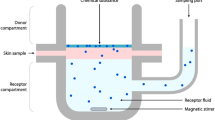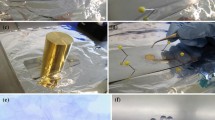Abstract
The institution of a readily-implemented sample screening and data handling procedure for in vitro skin penetration studies yields substantial improvements in sensitivity for distinguishing between formulations, treatments, penetrants, etc. The procedure involves four steps: 1) prescreen the tissue samples to determine their intrinsic permeability; 2) apply treatments using a randomized complete block (RGB) design, with blocking by tissue permeability; 3) apply a variance-stabilizing transformation to the penetration data, followed by outlier testing; and 4) analyze the transformed data according to an RGB analysis of variance, using tissue permeability as the blocking variable. For penetration studies in which high sample variability is a concern, the above procedure commonly yields a sensitivity advantage of several-fold versus alternative methods of comparison.
Similar content being viewed by others
REFERENCES
T. J. Franz. Percutaneous absorption. On the relevance of in vitro data. J. Invest. Dermatol. 64:190–195 (1975).
R. L. Bronaugh and R. F. Stewart. Methods for in vitro percutaneous absorption studies III: hydrophobic compounds. J. Pharm. Sci. 73:1255–1258 (1984).
R. L. Bronaugh and R. F. Stewart. Methods for in vitro percutaneous absorption studies VI: preparation of the barrier layer. J. Pharm. Sci. 75:487–491 (1986).
R. L. Bronaugh and S. W. Collier. In vitro methods for measuring skin permeation. Cosmet. Toiletries 105:86–89, 92–93 (1990).
J. P. Skelly, V. P. Shah, H. I. Maibach, R. H. Guy, R. C. Wester, G. Flynn, and A. Yacobi. FDA and AAPS report of the Workshop on Principles and Practices of In Vitro Percutaneous Penetration Studies: relevance to bioavailability and bioequivalence. Pharm. Res. 4:265–267 (1987).
D. R. Friend. In vitro skin permeation techniques. J. Control. Release 18:235–248 (1992).
K-C. T. Hoang et al., Dermal Exposure Assessment: Principles and Applications, Interim Report EPA/600/8-91/011/B of the U.S. Environmental Protection Agency, January, 1992.
P. Liu, J. A. S. Nightingale and T. Kurihara-Bergstrom. Variation of human skin permeation in vitro: Ionic vs neutral compounds. Int. J. Pharm. 90:171–176 (1993).
G. B. Kasting and L. A. Bowman. DC electrical properties of frozen, excised human skin. Pharm. Res. 7:134–143 (1990).
G. B. Kasting and L. A. Bowman. Electrical analysis of fresh, excised human skin: a comparison with frozen skin. Pharm. Res. 7:1141–1146 (1990).
T. J. Franz and P. A. Lehman. The use of water permeability as a means of validation for skin integrity in in vitro percutaneous absorption studies. J. Invest. Dermatol. 94:525 (1990).
G. B. Kasting, R. L. Smith, and E. R. Cooper, Effect of lipid solubility and molecular size on percutaneous absorption, in: B. Shroot and H. Schaeffer (eds.), Pharmacology of the Skin, Vol. 1, Karger, Basel, 1987, pp. 138–153.
W. J. Dixon and F. J. Massey. Introduction to Statistical Analysis, 3rd ed., McGraw-Hill, New York, 1969, pp. 328–330.
G. W. Snedecor and W. G. Cochran. Statistical Methods, 8th ed., Iowa State University Press, Ames, Iowa, 1989, pp. 278–281.
E. W. Merritt and E. R. Cooper. Diffusion apparatus for skin penetration. J. Control. Release 1:161–162 (1984).
G. W. Snedecor and W. G. Cochran. Statistical Methods, 8th ed., Iowa State University Press, Ames, Iowa, 1989, pp. 68–70.
G. E. Noether. Sample size determination for some common nonparametric tests. J. Amer. Stat. Assoc. 82:645–647 (1987).
R. Lehr. Sixteen S-squared over D-squared: a relation for crude sample size estimates. Stat. Med. 11:1099–1102 (1992).
M. S. Bartlett. The use of transformations. Biometrics 3:39–53 (1947).
G. F. P. Box and D. R. Cox. An analysis of transformations. J. Royal Stat. Soc. B 26:211–243 (1964).
G. W. Snedecor and W. G. Cochran. Statistical Methods, 8th ed., Iowa State University Press, Ames, Iowa, 1989, p. 290.
Author information
Authors and Affiliations
Rights and permissions
About this article
Cite this article
Kasting, G.B., Filloon, T.G., Francis, W.R. et al. Improving the Sensitivity of in Vitro Skin Penetration Experiments. Pharm Res 11, 1747–1754 (1994). https://doi.org/10.1023/A:1018915416930
Issue Date:
DOI: https://doi.org/10.1023/A:1018915416930




